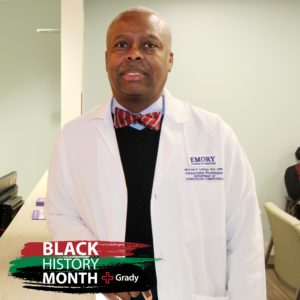
The first in his family to become a physician, Lindsay was inspired very early-on to follow the path of obstetrics. “I was the youngest of nine siblings, so I had older sisters who became parents and I was fascinated by pregnancy. By age seven, I was saying I wanted to be a ‘baby doctor.’”
When Michael Lindsay, MD, MPH first joined Grady in 1985, high risk pregnancy meant complications associated with high blood pressure, diabetes and substance abuse. But in 1986 there was a spike in HIV positive women, and with Lindsay’s help, Grady became one of the first hospitals in the country to establish an HIV clinic for pregnant women.
“It was a novel concept and new territory. There were no proven effective treatments or therapies at that time, but we created a safe space for women to turn to. We were here for them.”
Lindsay is a senior maternal fetal medicine clinician and chief of Emory service for obstetrics and gynecology at Grady, with more than three decades of clinical experience in managing high risk pregnancies.
His clinical research in the late 1980s was instrumental in establishing routine voluntary prenatal HIV testing for all patients, not just those with risk factors.
“We found that routine screening identified twice as many HIV positive women. Grady was the first in the country to screen everyone who consented.”
Lindsay’s long career is guided by two things: teaching up and coming physicians, and hopefully making a difference.
“I love working here. It’s rewarding and I am proud of my longevity in this field — I’ve cared for over a generation of patients.”
Schooling: Lindsay received a bachelor of science degree from Morehouse College in 1975, his medical degree from Yale School of Medicine in 1979, and a master of public health from Emory University School of Public Health in 1991.
The latter qualification came as a result of Lindsay’s aspiration to properly document what he was seeing with his high risk patients.
“I wanted to chronicle and report what was happening with HIV positive women in the clinic. I knew it would be important for long term research, and it was important to do it the right way, with the right tools.”
